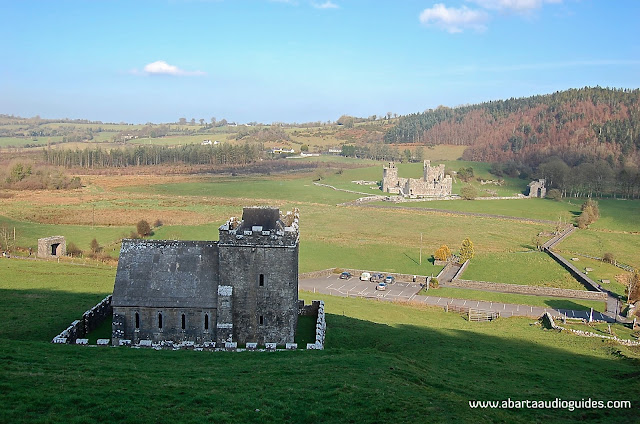 |
| Interior of the 10/11th Century St. Féichín's Church |
Most of structures forming the main part of Fore Abbey date to the period following the Norman invasion of Ireland. Hugh De Lacey ruled the Lordship of Meath (roughly speaking it incorporated today's Meath and Westmeath) from his fortress at Trim Castle. De Lacey would have appreciated the value of the monastery and the population growing around it. He had a priory established in around 1180 and gave the site to the Benedictine Order.
The Benedictine movement was extremely popular across the Continent, but there were not many Benedictine monasteries established in Ireland, and I can't think of another example as well preserved as Fore. It was constructed around a central cloister (a beautiful courtyard), with a church to the north, the dormitory for the monks to the east, the refectory to the south with its adjacent kitchen to the south-west.
 |
| The cloister area |
Despite these raids Fore Abbey was still a wealthy place and new towers and a revamped cloister area was added in the fifteenth century.
Fore is also known for the Seven Wonders of Fore. These are:
The Anchorite in a stone
The water that will not boil
The monastery built on a bog
The mill without a millstream
The water that flows uphill
The tree which will not burn
The stone lintel raised by the saints prayers
Fore Abbey is a wonderful place, the area is steeped in history and stunning ruins that you can easily spend an afternoon wandering around, especially if you are lucky enough to be there on a fine day too. The site is well signposted (see our map for its exact location) and provisioned with a large carpark, I highly recommend a visit!
I really hope that you enjoy our blog, if you like any of our images you might be interested to learn that you can now purchase prints from http://www.12greengiraffes.com/, take a look around the site to see what we have available and to see some sensational images of Connemara by the talented photographer Muireann Ní Cheallacháin, if there is an image from our blog that you'd like as a print please let me know by leaving a comment.
Is there a historical or cultural site in your area that you'd like us to cover? Or perhaps you might like to contribute a site to our blog? I'd love to hear from you, please send me a message at info@abartaaudioguides.com



